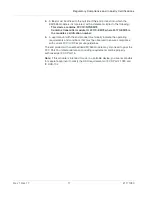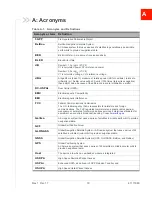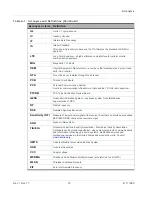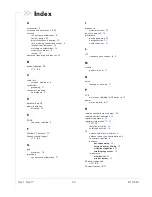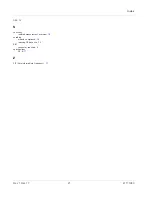
RF Specifications
Rev 1 Dec.17
11
41111980
Note: A diversity antenna is used to improve connection quality and reliability through
redundancy. Because two antennas may experience difference interference effects (signal
distortion, delay, etc.), when one antenna receives a degraded signal, the other may not be
similarly affected.
Ground Connection
When connecting the module to system ground:
•
Prevent noise leakage by establishing a very good ground connection to the
module through the host connector.
•
Connect to system ground using the module’s mounting hole.
•
Minimize ground noise leakage into the RF.
Depending on the host board design, noise could
potentially
be coupled to
the module from the host board. This is mainly an issue for host designs that
have signals traveling along the length of the module, or circuitry operating at
both ends of the module interconnects.
Interference and Sensitivity
Several interference sources can affect the module’s RF performance
(RF desense). Common sources include power supply noise and device-
generated RF.
RF desense can be addressed through a combination of mitigation techniques
(
Methods to Mitigate Decreased Rx Performance on page 12
) and radiated
sensitivity measurement (
Radiated Sensitivity Measurement on page 13
Note: The EM7565 is based on ZIF (Zero Intermediate Frequency) technologies. When
performing EMC (Electromagnetic Compatibility) tests, there are no IF (Intermediate
Frequency) components from the module to consider.
Interference From Other Wireless Devices
Wireless devices operating inside the host device can cause interference that
affects the module.
To determine the most suitable locations for antennas on your host device,
evaluate each wireless device’s radio system, considering the following:
•
Any harmonics, sub-harmonics, or cross-products of signals generated by
wireless devices that fall in the module’s Rx range may cause spurious
response, resulting in decreased Rx performance.
•
The Tx power and corresponding broadband noise of other wireless devices
may overload or increase the noise floor of the module’s receiver, resulting in
Rx desense.
The severity of this interference depends on the closeness of the other antennas
to the module’s antenna. To determine suitable locations for each wireless
device’s antenna, thoroughly evaluate your host device’s design.

















